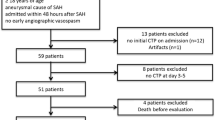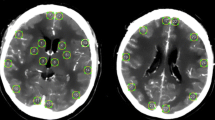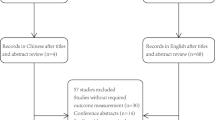Abstract
Early prediction of delayed cerebral ischemia (DCI) after aneurysmal subarachnoid hemorrhage (aSAH) is essential to prevent infarction. CT perfusion (CTP) is used to identify perfusion deficits and to guide treatment decisions. In this study, we aimed to evaluate CTP parameters and to establish cutoff values for DCI prediction in the early phase after aSAH. Whole-brain CTP was performed on day 3 after aSAH. These CTP parameters were analyzed: cerebral blood flow (CBF), cerebral blood volume (CBV), mean transit time (MTT), time to peak (TTP), time to start (TTS), and time to drain (TTD). ROC analysis was performed to establish cutoff values. The outcome (modified Rankin scale (mRS)) at 3 months follow-up and the DCI incidence were evaluated. A total of 64 patients were included. A good WFNS grade (I–III) was documented in 44% of the patients. A mild modified Fisher grade (1–2) was seen in 3% of the patients. Early perfusion deficits were found in 18 of 64 patients and 10 of them developed DCI. For DCI prediction, the following cutoff values were identified: TTD > 4.93 s, CBF < 53.93 ml/100 ml/min, MTT <> 4.25 s, TTS > 0.94 s, TTP > 9.28 s, and CBV < 3.14 ml/100 ml. The positive predictive value (PPV)/negative PV (NPV) was as follows: TTD 77%/93%; CBF 94%/70%; MTT 72%/96%; TTS 71%/86%; TTP 55%/78%; CBV 75%/61%. Early perfusion deficits correlated with DCI (logistic regression p < 0.0001) but not with outcome. CTP on day 3 after aSAH allows reliable DCI prediction. TTD had high NPV/PPV for DCI prediction and should be an integral part of quantitative CTP analysis in the early phase after aSAH.


Similar content being viewed by others
References
Al-Mufti F, Amuluru K, Smith B, Damodara N, El-Ghanem M, Singh IP et al (2017) Emerging markers of early brain injury and delayed cerebral ischemia in aneurysmal subarachnoid hemorrhage. World Neurosurg 107:148–159
Budohoski KP, Guilfoyle M, Helmy A, Huuskonen T, Czosnyka M, Kirollos R et al (2013) The pathophysiology and treatment of delayed cerebral ischemia following subarachnoid hemorrhage. J Neurol Neurosurg Psychiatry 85:1343–1353
Chun FL, Sandford PCH, Chung JL, Wan YG, Chih HL, Wie FC et al (2016) Prolonged cerebral circulation time is the best parameter for predicting vasospasm during initial CT perfusion in subarachnoid hemorrhagic patients. PLoS One 11:e0151772
Cremers CH, van der Schaaf IC, Wensink E, Greving JP, Rinkel GJ, Velthuis BK et al (2014) CT perfusion and delayed cerebral ischemia in aneurysmal subarachnoid hemorrhage: a systematic review and meta-analysis. J Cereb Blood Flow Metab 34:200–207
Cremers CH, Vos PC, van der Schaaf IC, Velthuis BK, Vergouwen MD, Rinkel GJ et al (2015) CT perfusion during delayed cerebral ischemia after subarachnoid hemorrhage: distinction between reversible ischemia progressing to infarction. Neuroradiology 57:897–902
Dankbaar JW, de Rooij NK, Rijsdijk M, Velthuis BK, Frijns CJ, Rinkel GJ et al (2010) Diagnostic threshold values of cerebral perfusion measured with computed tomography for delayed cerebral ischemia after aneurysmal subarachnoid hemorrhage. Stroke 41:1927–1932
Dolatowski K, Malinova V, Frölich AM, Schramm R, Haberland U, Klotz E et al (2014) Volume perfusion CT (VPCT) for the differential diagnosis of patients with suspected cerebral vasospasm: qualitative and quantitative analysis of 3D parameter maps. Eur J Radiol 83:1881–1889
Duan Y, Xu H, Li R, Zheng K, Hu Z, Wu N et al (2017) Computed tomography perfusion deficits during the baseline period in aneurysmal subarachnoid hemorrhage are predictive of delayed cerebral ischemia. J Stroke Cerebrovasc Dis 26:162–168
Etminan N, Beseoglu K, Heiroth HJ, Turowski B, Steiger HJ, Hänggi D (2013) Early perfusion computerized tomography imaging as a radiographic surrogate for delayed cerebral ischemia and functional outcome after subarachnoid hemorrhage. Stroke 44:1260–1266
Foreman B (2016) The pathophysiology of delayed cerebral ischemia. J Clin Neurophysiol 33:174–182
Francoeur CL, Mayer SA (2016) Management of delayed cerebral ischemia after subarachnoid hemorrhage. Crit Care 20:277
Frontera JA, Ahmed W, Zach V, Jovine M, Tanenbaum L, Sehba F et al (2015) Acute ischemia after subarachnoid haemorrhage, relationship with early brain injury and impact on outcome: a prospective quantitative MRI study. J Neurol Neurosurg Psychiatry 86:71–78
Fujii M, Yan J, Rolland WB, Soejima Y, Caner B, Zhang JH (2013) Early brain injury, an evolving frontiers in subarachnoid hemorrhage research. Trans Stroke Res 4:432–446
Honda M, Sase S, Yokota K, Ichbayashi R, Yoshihara K, Sakata Y et al (2013) Early cerebral circulatory disturbance in patients suffering subarachnoid hemorrhage prior to the delayed cerebral vasospasm stage: xenon computed tomography and perfusion computed tomography study. Neurol Med Chir 52:488–494
Malinova V, Dolatowski K, Schramm P, Moerer O, Rohde V, Mielke D (2016) Early whole-brain CT perfusion for detection of patients at risk for delayed cerebral ischemia after subarachnoid hemorrhage. J Neurosurg 125:128–136
Mir DIA, Gupta A, Dunning A, Puchi L, Robinson CL, Epstein HAB et al (2014) CT perfusion for detection of delayed cerebral ischemia in aneurysmal subarachnoid hemorrhage: a systematic review and meta-analysis. AJNR 35:866–871
Mursch K, Wachter A, Radke K, Buhre W, Al-Sufi S, Munzel U et al (2001) Blood flow velocities in the basal vein after subarachnoid hemorrhage. A prospective study using transcranial duplex sonography. Acta Neurochir 143:793–799
Oestergaard L, Aamand R, Karabegovic S, Tietze A, Blicher JU, Mikkelsen IK et al (2013) The role of the microcirculation in delayed cerebral ischemia and chronic degenerative changes after subarachnoid hemorrhage. J Cereb Blood Flow Metab 33:1825–1837
Rodriguez-Regent C, Hafsa M, Turc G, Ben Hassen W, Edjlali M, Sermet A et al (2016) Early quantitative CT perfusion parameters variation for prediction of delayed cerebral ischemia following aneurysmal subarachnoid hemorrhage. Eur Radiol 26:2956–2963
Rowland MJ, Hadjipavlou G, Kelly M, Westbrock J, Pattinson KT (2012) Delayed cerebral ischemia after subarachnoid hemorrhage: looking beyond vasospasm. Br J Anaesth 109:315–329
Sanelli PC, Anumula N, Johnson CE, Tsiouris AJ, Riina H, Segal AZ et al (2013) Evaluating CT perfusion using outcome measures of delayed cerebral ischemia in aneurysmal subarachnoid hemorrhage. AJNR 34:292–298
Sehba FA, Pluta RM, Zhang JH (2011) Metamorphosis of subarachnoid hemorrhage research: from delayed vasospasm to early brain injury. Mol Neurobiol 43:24–40
Sehba FA (2014) Rat endovascular perforation model. Trans Stroke Res 5:660–668
Sehba FA, Bederson JB (2006) Mechanisms of acute brain injury after subarachnoid hemorrhage. Neurol Res 28:381–398
Sun H, Li W, Ma J, Liu Y, You C (2017) CT perfusion diagnoses delayed cerebral ischemia in the early stage of the time-window after aneurysmal subarachnoid hemorrhage. J Neuroradiol 44:313–318
Tateyama K, Kobayashi S, Murai Y, Teramoto A (2013) Assessment of cerebral circulation in the acute phase of subarachnoid hemorrhage using perfusion computed tomography. J Nippon Med Sch 80:110–118
Terpolilli NA, Brem C, Bühler D, Plesnila N (2015) Are we barking up the wrong vessels? Cerebral microcirculation after subarachnoid hemorrhage. Stroke 46:3014–3019
Ulrich CT, Fung C, Vatter H, Setzer M, Gueresir E, Seifert V et al (2013) Occurrence of vasospasm and infarction in relation to a focal monitoring sensor in patients after SAH: placing a bet when placing a probe? PLoS One 8:e62754
van der Schaaf I, Wermer MJ, van der Graaf Y, Hoff RG, Rinkel GJ, Velthuis BK (2006) CT after subarachnoid hemorrhage: relation of cerebral perfusion to delayed cerebral ischemia. Neurology 66:1533–1538
Westermaier T, Pham M, Stetter C, Willner N, Solymosi L, Ernestus RI et al (2014) Value of transcranial Doppler, perfusion-CT and neurological evaluation to forecast secondary ischemia after aneurysmal SAH. Neurocrit Care 20:406–412
Williams JR (2008) The Declaration of Helsinki and public health. Bull World Health Organ 86:650–652
Author information
Authors and Affiliations
Corresponding author
Ethics declarations
I declare that I have no conflicts of interest. Ioannis Tsogkas, Daniel Behme, Veit Rohde, and Dorothee Mielke declare that they have no conflicts of interest. Marios Nikos Psychogios declares receiving speakers’ honoraria from Siemens.
The study was approved by the local ethics committee (Number 22/11/12). A patient’s consent for treatment was obtained according to the individual institutional guidelines. Due to a retrospective analysis of prospectively collected data additional informed consent was deemed unnecessary. This study was conducted according to the principles of the Helsinki Declaration [31]. This study was not funded.
Additional information
Publisher’s note
Springer Nature remains neutral with regard to jurisdictional claims in published maps and institutional affiliations.
Rights and permissions
About this article
Cite this article
Malinova, V., Tsogkas, I., Behme, D. et al. Defining cutoff values for early prediction of delayed cerebral ischemia after subarachnoid hemorrhage by CT perfusion. Neurosurg Rev 43, 581–587 (2020). https://doi.org/10.1007/s10143-019-01082-8
Received:
Revised:
Accepted:
Published:
Issue Date:
DOI: https://doi.org/10.1007/s10143-019-01082-8




